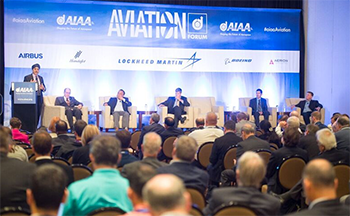Commercial Supersonic Travel Could Shrink the World Written 7 June 2017
Panelists: Moderator Peter Coen, project manager of commercial supersonic technology, NASA’s Langley Research Center; Michael Buonanno, deputy chief engineer, QueSST X-Plane, Lockheed Martin; Robert Cowart, director of supersonic technology development, Gulfstream Aerospace; Vik Kachoria, president and CEO, Spike Aerospace; Blake Scholl, founder and CEO, Boom Technology; Gurdip Singh Ubhi, business development executive, Rolls-Royce
by Tom Risen, Aerospace America Staff Reporter (2017-2018)

Advances including aerodynamics, propulsion and composites can make supersonic flight more affordable and open more travel routes than the commercial flights once offered by the British Airways Concorde, a panel of aviation executives said during the 2017 AIAA AVIATION Forum in Denver.
Supersonic flight can “shrink the world” the same way subsonic jet flight did by making it easier for families to visit relatives or vacation or for executives to make business trips, Blake Scholl, founder and CEO of Colorado-based startup Boom Technology, said June 6 in the “Supersonic Transport” panel.
The Concorde had a top speed of Mach 2, or more than 2,000 kph, when it flew commercial flights between 1976 and 2003. The plane was too expensive to fly on limited commercial routes, however, so it “was an economic catastrophe,” Scholl said.
Advances including carbon composites and improved propulsion, however, make it more affordable to build a new generation commercial supersonic jet, Scholl said. In 2018, Boom plans to test the XB-1, a prototype version one-third the size of a supersonic airliner it hopes to debut and certify in the early 2020s.
Supersonic flight, however, creates noise that can not only disturb people and wildlife, but also can have environmental impact — like causing avalanches in mountain ranges, said Vik Kachoria, CEO of Spike Aerospace in Boston.
For this reason, the FAA banned supersonic flights over land even before Concordes began flying over the Atlantic. Reducing the noise of a sonic boom could make it more acceptable for regulators in the U.S. and Europe to allow supersonic flight routes around the world that could take hours off travel time.
To address the noise problem, Spike is developing its S-512 Quiet Supersonic Jet, which aims to cruise with 18 passengers at Mach 1.6 without producing a loud, disturbing sonic boom on the ground, Kachoria said.
This new generation of supersonic commercial travel will be available mainly to the “super rich for now,” Kachoria said, adding there will be a demand for people to travel to London for important business meetings within three or four hours.
“We’ll figure out how to do it better, faster, larger,” he said.
Selling supersonic jets or commercial flights to the wealthy who can afford it “breaches the market; it opens the door,” said Robert Cowart, director of supersonic technology development at Gulfstream Aerospace.
